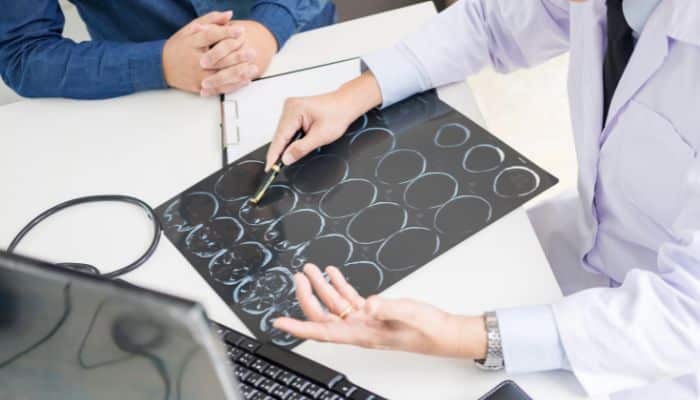4 min read
Unlocking Sensory Breakthroughs: A Comprehensive Guide to Understanding DSEP Technique for Assessing Improvement in Dermatomes
Unlocking Sensory Breakthroughs: A Comprehensive Guide to Understanding DSEP Technique for Assessing Improvement in Dermatomes
Welcome to our comprehensive guide on the groundbreaking DSEP technique, designed to assess sensory improvement in dermatomes. If you’re unfamiliar with dermatomes, they are specific areas of skin innervated by different spinal nerves. This technique, known as Dermatomal Somatosensory Evoked Potentials (DSEP), allows healthcare professionals to evaluate changes in sensory function and detect breakthroughs that might go unnoticed with traditional methods.
In this guide, we will delve into the intricate details of the DSEP technique, shedding light on its benefits, applications, and how it aids in assessing improvement in dermatomes. Whether you’re a healthcare provider looking to enhance your diagnostic capabilities or a patient seeking a deeper understanding of your condition, this guide will provide invaluable insights.
Unlock sensory breakthroughs with the DSEP technique and empower yourself with knowledge. Join us as we explore this innovative approach and unlock the potential for improved outcomes.

What are dermatomes and why are they important?
Dermatomes play a crucial role in understanding how our nervous system functions. These are specific areas of skin that are innervated by different spinal nerves. By mapping out dermatomes, healthcare professionals can identify potential nerve damage, spinal cord injuries, and other neurological disorders.
Dermatomes are essential because they provide valuable information about the sensory function of different areas of the body. They help healthcare providers pinpoint the source of pain, numbness, or other sensory abnormalities. By understanding the concept of dermatomes, healthcare professionals can better diagnose and treat patients with neurological conditions.
Understanding dermatomes is the first step towards unlocking the potential for sensory breakthroughs. The ability to accurately assess sensory function in specific areas of the body is invaluable in the field of healthcare. This is where the DSEP technique comes into play.
Understanding sensory breakthroughs
Sensory breakthroughs occur when there is a notable improvement in sensory function within a specific dermatome. This can manifest as increased sensation, reduced pain, or improved motor control. These breakthroughs can be indicators of neurological recovery or successful interventions.
Traditionally, sensory breakthroughs were assessed through subjective patient reports and qualitative assessments. However, these methods often lacked objectivity and were unable to capture subtle changes in sensory function. The DSEP technique revolutionizes this process by providing healthcare professionals with a quantitative and reliable method for assessing sensory improvement.
By understanding and recognizing sensory breakthroughs, healthcare providers can tailor treatment plans and interventions to maximize patient outcomes. The DSEP technique enables healthcare professionals to track progress, identify areas of improvement, and make informed decisions based on objective data.

How the DSEP technique works
The DSEP technique involves the measurement of somatosensory evoked potentials, which are electrical signals generated by the nervous system in response to sensory stimuli. By stimulating specific dermatomes and recording the evoked potentials, healthcare professionals can assess the integrity and functionality of the sensory pathways.
The process begins with the placement of electrodes on the patient’s scalp and along the spinal cord. These electrodes detect the electrical signals generated by the nervous system. Next, a sensory stimulus, such as a mild electrical current or a vibration, is applied to the targeted dermatome. The evoked potentials generated by the sensory stimulus are recorded by the electrodes and analyzed using specialized software.
The recorded evoked potentials are then compared to established norms, allowing healthcare professionals to determine the integrity of the sensory pathways. This information can help identify areas of dysfunction, assess the severity of nerve damage, and monitor changes in sensory function over time.
The DSEP technique provides objective and quantifiable data, allowing for accurate assessments of sensory improvement in dermatomes. It is a non-invasive and safe procedure that can be performed in a clinical setting. By incorporating the DSEP technique into their practice, healthcare professionals can obtain valuable insights into their patients’ sensory function and track progress effectively.
Benefits of using the DSEP technique
The DSEP technique offers several benefits over traditional methods of assessing sensory improvement. Here are some of the key advantages:
- Objective assessment: Unlike subjective patient reports, the DSEP technique provides objective data that can be used to monitor changes in sensory function over time. This data is valuable for tracking progress, evaluating the effectiveness of interventions, and making informed decisions about patient care.
- Early detection of breakthroughs: The DSEP technique can detect subtle changes in sensory function that may go unnoticed with traditional methods. This early detection allows for prompt intervention and can potentially lead to improved patient outcomes.
- Quantitative measurements: The DSEP technique provides quantitative measurements of sensory improvement, allowing healthcare professionals to assess the magnitude of changes with precision. This data can be used to establish baselines, track progress, and compare results between different patients.
- Enhanced diagnostic capabilities: By incorporating the DSEP technique into their practice, healthcare professionals can enhance their diagnostic capabilities. The ability to accurately assess sensory function in dermatomes can aid in the diagnosis of neurological conditions, guide treatment planning, and monitor the effectiveness of interventions.
- Improved patient experience: The DSEP technique offers a non-invasive and safe method for assessing sensory improvement. This can lead to a more comfortable and positive patient experience, promoting patient satisfaction and compliance with treatment plans.
The benefits of using the DSEP technique are clear. By embracing this innovative approach, healthcare professionals can unlock the full potential of sensory assessment and improve patient care.
Case studies and success stories
The effectiveness of the DSEP technique is supported by numerous case studies and success stories. These real-life examples demonstrate the power of this innovative approach in assessing sensory improvement in dermatomes.
One case study involved a patient with a spinal cord injury who underwent intensive rehabilitation. By incorporating the DSEP technique into the patient’s treatment plan, the healthcare team was able to track the patient’s progress accurately. Over time, they observed significant sensory breakthroughs in multiple dermatomes, indicating neurological recovery. This breakthrough helped guide further interventions and led to improved motor control and quality of life for the patient.
Another success story involved a patient with chronic pain in a specific dermatome. Traditional methods of assessing sensory improvement failed to detect any significant changes. However, when the DSEP technique was employed, it revealed subtle improvements in sensory function. This breakthrough allowed the healthcare team to adjust the patient’s treatment plan, resulting in reduced pain and improved overall well-being.
These case studies and success stories highlight the transformative potential of the DSEP technique in assessing sensory improvement. By providing objective data and enabling early detection of breakthroughs, this technique has the ability to revolutionize the field of sensory assessment and improve patient outcomes.
Implementing the DSEP technique in clinical practice
Integrating the DSEP technique into clinical practice requires careful consideration and planning. Here are some key factors to consider when implementing this innovative approach:
- Training and education: Healthcare professionals need proper training and education to effectively utilize the DSEP technique. Specialized courses and workshops are available to provide the necessary knowledge and skills. It is essential to invest in training to ensure accurate and reliable assessments.
- Equipment and technology: The DSEP technique requires specialized equipment and technology, including electrodes, amplifiers, and software for data analysis. It is crucial to invest in high-quality equipment to ensure accurate measurements and reliable results.
- Collaboration and interdisciplinary approach: Implementing the DSEP technique often involves collaboration between different healthcare disciplines. It is important to foster interdisciplinary communication and cooperation to optimize patient care and achieve the best outcomes.
- Documentation and record-keeping: Accurate documentation and record-keeping are essential when using the DSEP technique. This includes recording patient information, test results, and any changes in sensory function. Proper documentation ensures continuity of care and facilitates data analysis for research and quality improvement initiatives.
By carefully considering these factors, healthcare professionals can successfully implement the DSEP technique into their clinical practice and unlock the potential for improved outcomes.
Training and certification for using the DSEP technique
To ensure accurate and reliable assessments, healthcare professionals using the DSEP technique should undergo proper training and certification. Several organizations offer specialized courses and workshops designed to provide the necessary knowledge and skills.
These training programs typically cover topics such as the underlying principles of the DSEP technique, electrode placement, stimulation protocols, data analysis, and interpretation of results. Hands-on training and practical experience are also essential components of these programs.
Upon completion of the training program, healthcare professionals can obtain certification, demonstrating their competence in using the DSEP technique. This certification serves as a credential and ensures that healthcare professionals adhere to the highest standards of practice.
Continuing education is also crucial to stay updated with the latest advancements in the field. Healthcare professionals should actively seek opportunities for ongoing learning and professional development to enhance their skills and knowledge.
Common misconceptions about the DSEP
technique
As with any innovative approach, there are common misconceptions surrounding the DSEP technique. Let’s address some of these misconceptions to provide a clearer understanding:
1. Misconception: The DSEP technique is invasive and painful.
– Reality: The DSEP technique is non-invasive and safe. It involves the placement of electrodes on the scalp and along the spinal cord, which is well-tolerated by patients. The sensory stimuli used are mild and do not cause pain or discomfort.
2. Misconception: The DSEP technique is time-consuming and resource-intensive.
– Reality: While the DSEP technique may require specialized equipment and training, it can be integrated into clinical practice efficiently. With proper planning and workflow optimization, healthcare professionals can incorporate the DSEP technique into their routine assessments without significant disruption.
3. Misconception: The DSEP technique is only applicable to certain conditions.
– Reality: The DSEP technique can be used to assess sensory improvement in a wide range of conditions, including spinal cord injuries, peripheral nerve injuries, and neurological disorders. Its versatility makes it a valuable tool for healthcare professionals across various disciplines.
4. Misconception: The DSEP technique provides subjective results.
– Reality: The DSEP technique provides objective and quantitative measurements of sensory improvement. The evoked potentials recorded by the electrodes are analyzed using specialized software, ensuring accurate and reliable results.
By dispelling these misconceptions, healthcare professionals can embrace the DSEP technique with confidence and utilize its full potential in assessing sensory improvement.
Conclusion: The future of sensory assessment
with the DSEP technique
Unlock the potential for sensory improvement with the DSEP technique. Embrace this groundbreaking approach and empower yourself with knowledge and expertise.
—
Disclaimer: The information provided in this article is for educational purposes only and should not be considered as medical advice. Please consult with a qualified healthcare professional for personalized diagnosis and treatment.
